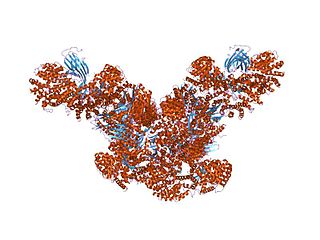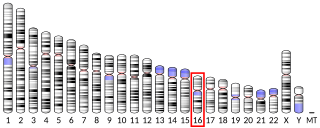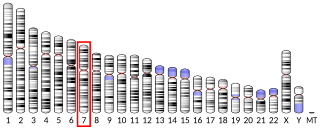
AP-2 complex subunit alpha-1 is a protein that in humans is encoded by the AP2A1 gene.

Clathrin heavy chain 1 is a protein that in humans is encoded by the CLTC gene.

AP-1 complex subunit beta-1 is a protein that in humans is encoded by the AP1B1 gene.

AP-2 complex subunit beta is a protein that in humans is encoded by the AP2B1 gene.

Charged multivesicular body protein 2b is a protein that in humans is encoded by the CHMP2B gene. It forms part of one of the endosomal sorting complexes required for transport (ESCRT) - specifically ESCRT-III - which are a series of complexes involved in cell membrane remodelling. CHMP2B forms long chains that spiral around the neck of a budding vesicle. Along with the other components of ESCRT-III, CHMP2B constricts the neck of the vesicle just before it is cleaved away from the membrane.

AP-3 complex subunit beta-1 is a protein that in humans is encoded by the AP3B1 gene.

AP-1 complex subunit gamma-like 2 is a protein that in humans is encoded by the AP1G2 gene.

AP-3 complex subunit mu-1 is a protein that in humans is encoded by the AP3M1 gene.

Trafficking protein particle complex subunit 3 is a protein that in humans is encoded by the TRAPPC3 gene.

Protein SEC13 homolog is a protein that in humans is encoded by the SEC13 gene.

Cerebellar degeneration-related protein 2 is a protein that in humans is encoded by the CDR2 gene.

AP-3 complex subunit sigma-2 is a protein that in humans is encoded by the AP3S2 gene.

AP-2 complex subunit sigma is a protein that in humans is encoded by the AP2S1 gene.

AP-3 complex subunit sigma-1 is a protein that in humans is encoded by the AP3S1 gene.

AP-4 complex subunit beta-1 is a protein that in humans is encoded by the AP4B1 gene.

AP-4 complex subunit mu-1 is a protein that in humans is encoded by the AP4M1 gene.

Robert Bernard Darnell is an American neurooncologist and neuroscientist, founding director and former CEO of the New York Genome Center, the Robert and Harriet Heilbrunn Professor of Cancer Biology at The Rockefeller University, and an Investigator of the Howard Hughes Medical Institute. His research into rare autoimmune brain diseases led to the invention of the HITS-CLIP method to study RNA regulation, and he is developing ways to explore the regulatory portions—known as the "dark matter"—of the human genome.

Dystrobrevin beta is a protein which in humans is encoded by the DTNB gene.

AP-4 complex subunit epsilon-1 is a protein that in humans is encoded by the AP4E1 gene.

AP-4 complex subunit sigma-1 is a protein that in humans is encoded by the AP4S1 gene.


















